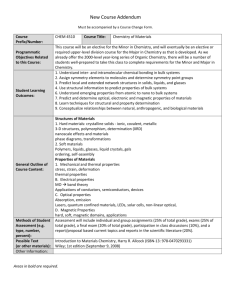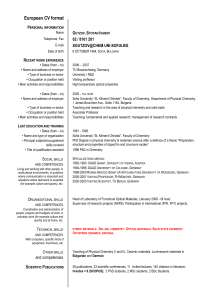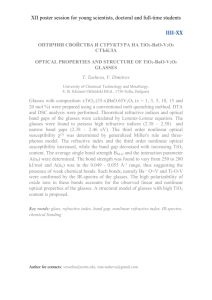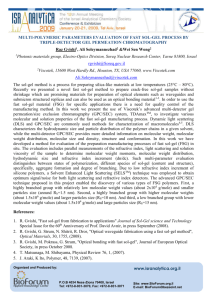Course- Materials for Photonic Applications
advertisement
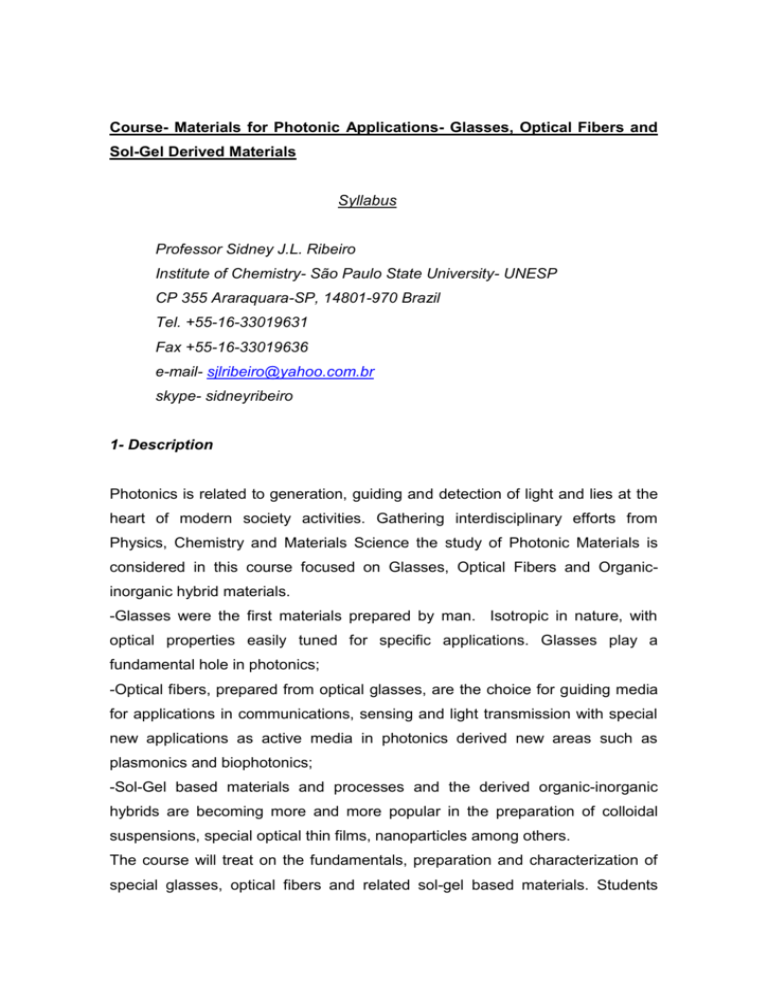
Course- Materials for Photonic Applications- Glasses, Optical Fibers and Sol-Gel Derived Materials Syllabus Professor Sidney J.L. Ribeiro Institute of Chemistry- São Paulo State University- UNESP CP 355 Araraquara-SP, 14801-970 Brazil Tel. +55-16-33019631 Fax +55-16-33019636 e-mail- sjlribeiro@yahoo.com.br skype- sidneyribeiro 1- Description Photonics is related to generation, guiding and detection of light and lies at the heart of modern society activities. Gathering interdisciplinary efforts from Physics, Chemistry and Materials Science the study of Photonic Materials is considered in this course focused on Glasses, Optical Fibers and Organicinorganic hybrid materials. -Glasses were the first materials prepared by man. Isotropic in nature, with optical properties easily tuned for specific applications. Glasses play a fundamental hole in photonics; -Optical fibers, prepared from optical glasses, are the choice for guiding media for applications in communications, sensing and light transmission with special new applications as active media in photonics derived new areas such as plasmonics and biophotonics; -Sol-Gel based materials and processes and the derived organic-inorganic hybrids are becoming more and more popular in the preparation of colloidal suspensions, special optical thin films, nanoparticles among others. The course will treat on the fundamentals, preparation and characterization of special glasses, optical fibers and related sol-gel based materials. Students activities include on-line itetractive sessions tand experimental sessions for those attending the course at Araraquara, Brazil. Seminars, with contents distributed to all participants, will be proposed for attendants in order to improve interactions among them. 2-Objectives -to introduce students to the role of Photonics in 21st century compared to the one of electronics in the last century; -to introduce students to Glasses and derived materials like optical fibers and planar waveguides and glass-ceramics, and their preparation methods; -to introduce students to “Soft Chemistry”, “Sol-Gel Materials” and “OrganicInorganic Hybrids” -to introduce students to Rare Earths ions Spectroscopic properties and how these properties can be explored in new opto-electronic devices -to introduce students to “Self-Assembly” phenomena and their relationship to importante devices produced by using this concept and also bioinspiration and biomimicry in Chemistry; 3-Course Topics 3.1-Glasses (Definitions; Glass materials; Glass properties; Optical glasses) 3.2-Characterization techniques (Long and short order characterization; Vibrational spectroscopy- Raman scattering and Infrared absorption; X-rays absorption fine structure (EXAFS); Nuclear Magnetic Resonance (NMR)) 3.3-Glass-Ceramics (Definitions; Glass-ceramics properties;Transparent glassceramics) 3.4-Waveguides (Optical fibers; Planar and chanel waveguides;Integrated Optics; Applications -Fiber sensors-Photonic band gap fibers -Stimulated emission- Lasers and optical amplifiers) 3.5-Spectroscopic properties of lanthanide ions (luminescence, down-shifiting, down-conversion, up-conversion) 3.6-Sol-Gel Methodology (Colloids; Nanotechnology; Sol-Gel Process, Organicinorganic hybrids; Applications- Self-Assembly, Emergent properties, Nanotechnology, Biooinspiration and biomimicry in Chemistry) 4-References Books 4.1- "Glasses and Glass-Ceramics"- Ed. M.H.Lewis, Chapman and Hall, 1989. 4.2- "Glass Science"- R.H.Doremus- John Wiley & Sons, 1973 4.3- "Fluoride glasses"- Ed. A.E.Comyns, John Wiley & Sons, 1989. 4.4- "Les Verres et L''Etat Vitreaux"- J.Zarzycki, Masson, 1982. 4.5- "Chemistry of Glasses- A.Paul, Chapman and Hall, 1982. 4.6- "Glass-Ceramics"- P.W.McMillan, Academic Press, 1979. 4.7- "Physics of Amorphous Materials", S.R.Elliot, Longman, 1990. 4.8- "Glass- Structure by Spectroscopy", J.Wong and C.A.Angell, Marcel Dekka, 1976. 4.9- G. Jeffrey Brinker, George W. Scherrer, “Sol-gel Science: The Physics and Chemistry of Sol-Gel Processing, Academic Press, 1990 4.10- Lisa C. Klein, “Sol-Gel Optics: Processing and Applications, Kluwer Academic Publishers, 1994 4.11- Pier L. Luisi, "The Emergence of Life- From Chemical Origins to Synthetic Biology", Cambridge University Press, Cambridge, England,2006. 4.12- Janos H. Fendler, "Nanoparticles and Nanostrcutured FilmsPreparation, characterization and applications", Wiley-VCH Verlag GmbH, Weinheim, Germany , 1998. 4.13- Stephen Mann, "Biomineralization- Principles and Concepts in Bioinorganic Materials Chemistry", Oxford Chemistry Masters, Oxford University Press, Oxford, 2001. 4.14- Paras Prasad, "Nanophotonics", John Wiley & Sons, Inc., Hoboken, New Jersey, USA, 2004. 4.15 Paras Prasad, "Introduction fo Biophotonics", John Wiley & Sons, Inc., Hobokne, New Jersey, USA, 2003. 4.16- Guido Kickelbick (Ed.), "Hybrid Materials- Synthesis, Characterization and Applications", Wiley-VCH Verlag GmbH & Co. KGaA, Weinheim, Germany, 2007. 4.17- Gerhard F. Swigers (Ed.), “Bioinspiration and biomimicry in Chemistry”, John Wiley & Sons, 2012. 4.18-V.S.Sastri, J-C.Bunzli, V.Ramachandra Rao, G.V.S.Rayudu, J.R.Perumareddi, “Modern Aspects of Rare Earths and their Complexes”, Elsevier, 2003. Papers 4.18- Michail Barboiu, Jean-Marie Lehn, “Dynamical chemical devices: modulation of contraction/extension molecular motion by coupled-ion binding/pH change- induced structural switching, PNAS, 2002, 99(8), 52015206 4.19- George M. Whitesides and Amy P. Wong, “The intersection of biology and materials science”, MRS Bulletin, 2006, 31, 19. 4.20- Andres W. Martinez, Scotte T. Phillips, Emanuel Carrilho, Samuel W. Thoomas III, Hayat Sindi, George M. Whitesides, “Simple telemedicine for developing regions: camera phones and paper-based microfluidic devices for real-time, off-site diagnosis”, Anal. Chem. 2008, 80, 3699. 4.21- George M. Whitesides and Darren J. Lipome, “Soft nanotrechnology: Structure vs function”, Faraday Discuss., 2009, 143, 373. 4.22- Luis D. Carlos, Rute A.S.Ferreira, Verónica Zéa-Bermudez, Sidney J.L.Ribeiro, “Lanthanide-containing light emitting organic-inorganic hybrids: a bet on the future”, Adv. Mater. 2009, 21, 509-534 4.23J.C. Bunzli, S.V.Eliseeva, “Lanthanide NIR luminescence for telecommunications, bioanalyses and solar energy conversion”, J. Rare Earthc 28(6)824(2010) 4.24- Jean-Marie Lehn, “Par-delà la synthèse: l´auto-organization”, C.R. Chimie 14(2011) 348-361 4.25- Darren J. Lipomi, Ramses V. Martinez, Michail A. Kats, Sung H. Kang, P. Kim, Joanna Aizenberg, Federico Capasso, George M. Whitesides, “Patterning the tips of optical fibers with metallic nanosctructures using nanoskiving”, Nano Lett. 2011, 11, 632. 4.26- Sindy K.Y. Tang, Ratmir Derda, Qimin quan, Marki Lonear, George M. Whitesides, “Continuously tunable microdroplet-laser in a microfluidic channel”, Opt. Express 2011, 19(3), 2204 4.27- George M. Whitesides and John Deutch, “Let´s get practical”, Nature, 2011, 469, 21. 4.28- Stephen A. Morin, Robert F. Shepherd, Sen Wai Kwok, Adam A. Stokes, Alex Nemiroski, George M. Whitesides, “Camouflage and Display for Soft Machines”, Science, 2012, 337, 828. 4.29- Shuai Lou, Xingmei Guo, Tongxiang Fan, Di Zhang, “Butterflies: inspiration for solar cells and sunlight water-splitting catalysts”, Energy Environ. Sci. 2012, 5, 9195 5- Grading policy Final grades will be calculated taking into account: -Weekly proposed follow-up quizzes -Midterm and final evaluation -Seminars prepared by participants to be distributed on-line 6- Course Schedule 2 hours pre-recorded weekly sessions to be downloaded 1 hour weekly on-line sessions with tutors and responsible for the classes Schedule (8:30-10:30 a.m.- Brasilia (Brazil) Time- UCT/GMT -3 hours) Abril- 9, 16, 23 May- 7, 14, 21 28 June- 4, 11, 18, 25
